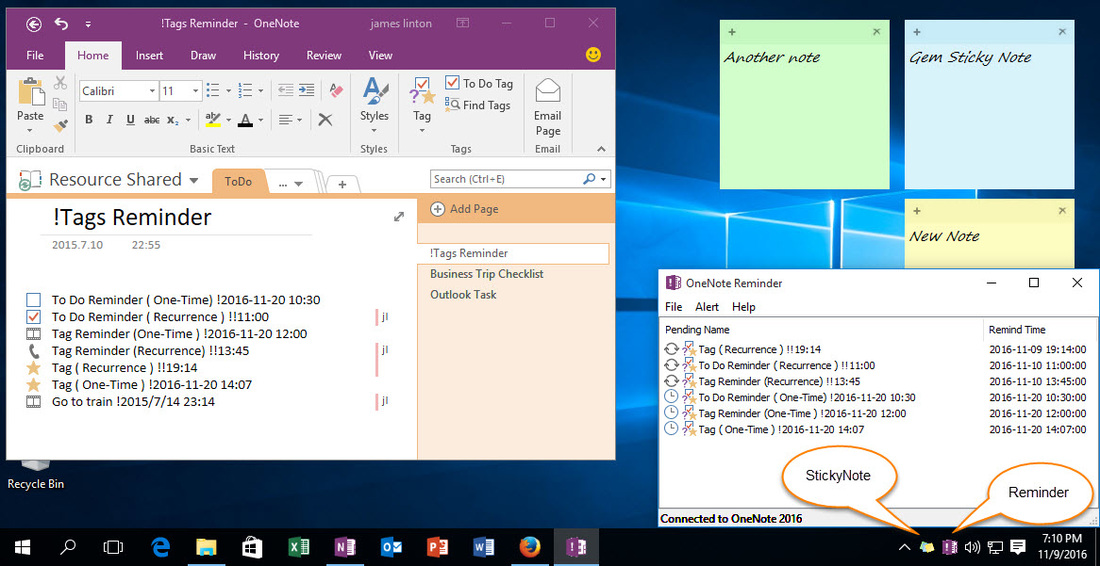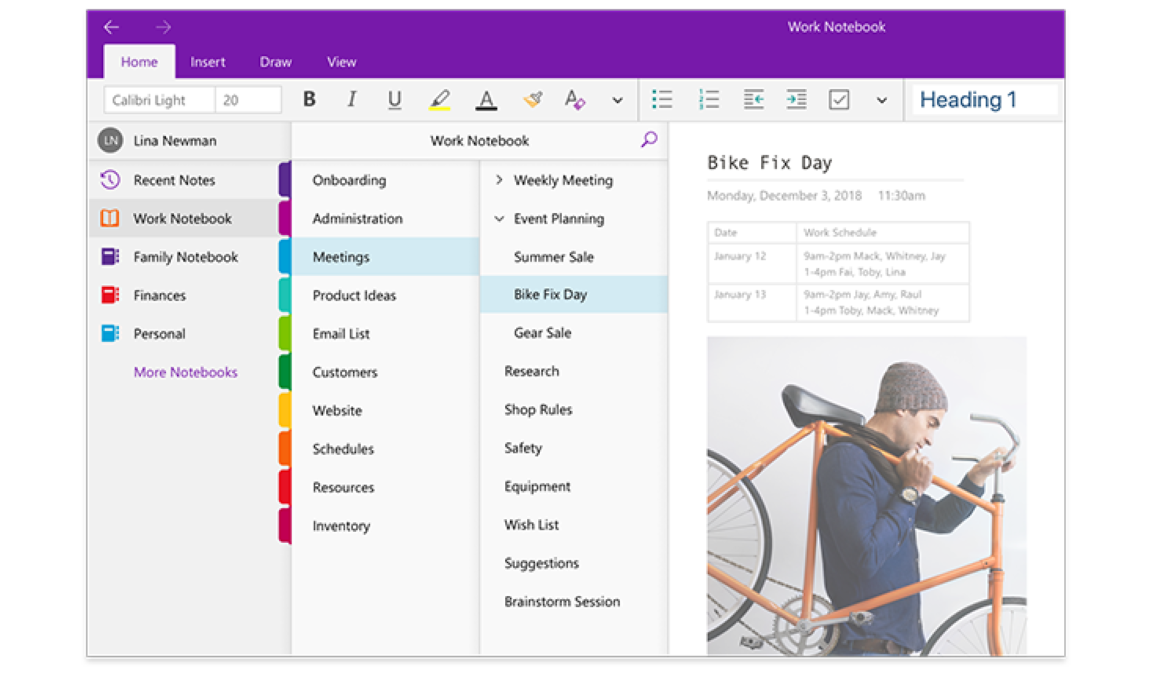 -->
-->There are two versions of OneNote that you can deploy to users in your organization who have devices running Windows:
- OneNote: the desktop version, which was previously named OneNote 2016.
- OneNote for Windows 10: the Microsoft Store app that's available only on Windows 10.
OneNote in education Teachers can use OneNote to organize lesson plans in searchable digital notebooks, and staff can create a sharable content library. A DLL side loading vulnerability was found in Microsoft Office OneNote 2007. This issue can be exploited by loading the Microsoft Office OneNote Mobile ActiveSync Provider for Desktop object as an embedded OLE object. When instantiating the object Windows will try to load the DLL ceutil.dll from the current working directory.
While both versions are supported and can be installed on the same device, OneNote is the recommended version for enterprise environments. OneNote provides more features and allows you to customize user settings through Group Policy.
Note
OneNote still appears as OneNote 2016 for the following installations:
- Version 2003 or earlier of Microsoft 365 Apps
- Volume licensed versions of Office 2019, such as Office Professional Plus 2019.
OneNote deployment guidance

You can use the Office Deployment Tool or enterprise deployment software, such as Microsoft Endpoint Configuration Manager, to include or exclude OneNote when you deploy Office in your organization.
As of March 2020, OneNote is included alongside the other Office apps, such as Word, Excel, and PowerPoint, when you deploy Microsoft 365 Apps or Office 2019. There are no additional steps you need to take to include OneNote with new installations of Office. But, always be sure to check the deployment settings before you deploy, for example when using the wizards in Configuration Manager (current branch) or Microsoft Intune.

To add OneNote to an existing installation of Office
If Office is already installed on the device, but OneNote didn't get installed previously, you can run the Office Deployment Tool on the device and use the following configuration.xml file to add OneNote.
Although you're deploying the freemium version of OneNote, the first time the user opens OneNote after it's installed, the license will update automatically to the same license as the version of Office already installed on the device.
Note
- Using OneNoteFreeRetail isn't supported with volume licensed versions of Office 2019, such as Office Professional Plus 2019 or Office Standard 2019. To add OneNote back to those versions of Office, you can run an Online Repair.
- If you deploy the freemium version of OneNote, when you go to Control Panel > Programs > Programs and Features, OneNote will appear as a standalone entry named Microsoft OneNote Home and Student 2016.
To exclude OneNote from being installed
There are different ways to exclude OneNote from being installed with Office, depending on which deployment method you're using, as shown in the following table.
| Method | Instructions |
|---|---|
| Office Deployment Tool | You can use the ExcludeApp element in your configuration.xml file. We recommend that you use the Office Customization Tool to help you create your configuration.xml file. |
| Microsoft Endpoint Configuration Manager (current branch) | In the Office 365 Client Installation wizard, you can set OneNote to the Off position when you configure the Office settings. |
| Microsoft Intune | On the Configure app suite page, you can clear the check box for OneNote in the Select Office apps drop-down list. |
But, if you're allowing your users to install Office for themselves from the Office 365 portal, there is no way to exclude OneNote from being installed.
Office Onenote
OneNote for Windows 10 deployment guidance
OneNote for Windows 10 is installed by default on computers running Windows 10. Users can also install it directly from the Microsoft Store, if you allow them to install apps from there. In either case, updates to OneNote for Windows 10 come directly from the Microsoft Store.
If you don't want your users to install apps directly from the Microsoft Store, you can set up the Microsoft Store for Business in your organization. This option allows you to control which Microsoft Store apps your users can install, including OneNote for Windows 10. For more information, see Microsoft Store for Business overview
If your users already use OneNote for Windows 10, they may continue to use it. We recommend excluding OneNote for Windows 10 for new deployments. We don't recommend uninstalling OneNote for Windows 10 for existing users because uninstalling an app permanently removes any notebook changes in the local cache that haven't been synchronized. If you plan to uninstall OneNote for Windows 10 for existing users, ensure that all open notebooks have finished synchronizing before uninstalling.
All notebooks supported by OneNote for Windows 10 are also fully supported by OneNote. All cloud-based notebooks associated with their user account will be accessible in OneNote after they sign in with that same user account.
To exclude OneNote for Windows 10 from a Windows image
To remove OneNote for Windows 10 from a Windows image so that OneNote for Windows 10 won't be installed when a new user account is created, you can use the Remove-AppxProvisionedPackage cmdlet. For the package name parameter, you should use Microsoft.Office.OneNote_2015.9126.21251.0_neutral_~_8wekyb3d8bbwe.
Additional information about deploying OneNote
OneNote training resources We're providing free and shareable eBooks to help your users transition to the user interface and functionalities in OneNote.
Configure OneNote settings: You can use Group Policy to configure certain OneNote settings for your users. To use Group Policy, download the latest Administrative Template files (ADMX/ADML) for Office from the Microsoft Download Center and implement the policy settings by using Active Directory Domain Services (AD DS).
Note
- Group Policy requires the devices with OneNote to be joined to an Active Directory domain.
- Most of these same policy settings can be applied by using the Office cloud policy service, which doesn't require the device to be joined to a domain.
- Neither Group Policy nor Office cloud policy service can be used with Microsoft 365 Apps for business or with OneNote for Windows 10.
Support dates: In November 2019, we announced that mainstream support for OneNote will continue until October 2023. Extended support remains the same, ending in October 2025. These dates align with the support dates for Office 2019. These specific support dates apply only to OneNote included with versions of Office, such as Office Professional Plus 2016, that are available as a one-time purchase or through volume licensing agreements.
Supported languages: While both OneNote and OneNote for Windows 10 are available in most of the same languages, there are a few differences. The lists of the supported languages are available here: OneNote, OneNote for Windows 10
Other platforms: There are also versions of OneNote for Mac, iPad, iPhone, Android, and for web browsers. For more information, see What's the difference between the OneNote versions?
Related articles
Craig GerdesOffice Onenote Training
Essentially, it is a digital notebook available anytime, anywhere. OneNote is available as a traditional desktop app, a web app, and a mobile app. In addition, a simplified OneNote version comes pre-installed with Windows 10. The features available to the user depend on the version and environment used.
Office Onenote 2017
- You can create sections and pages just like a traditional notebook, then save and organize your typed or handwritten notes, and other stuff such as photos, files, links to websites, screen clippings, videos, etc.
- You can create further navigational structure by creating section groups or subpages and your own templates.
- You can search for items by text, tags, or author.
- OneNote integrates easily with Microsoft Outlook and other Office products.
- You can email a message to OneNote or email notes captured in OneNote to others. Items assigned in OneNote appear as Tasks in Outlook.
- You can easily send Word and PowerPoint files to OneNote.
- You can take notes based on a Word document or PowerPoint presentation and link the notes to the original source file for reference.
- You can share your notebooks with specific people through a direct email or to the world through a sharing link.
- You can set permissions to view only or with editing privileges. You can password protect sections.
- You can view recent edits and revert to a previous version if necessary.
- You can do other cool things too.
- For example, you can ask Cortana or Siri to take notes for you.
- Another thing you can do is covert handwritten notes to text.
- Finally, you can take notes on a webpage and then save a screen clip with annotations to OneNote.
There are several ways to use OneNote at school, work, or home. For a great list of examples and ideas, check out:
10 Unique Ways to Use Microsoft OneNote
111 Ways to Use Microsoft OneNote
The screenshot below is an example of a class notebook that shares file attachments with students for download. In addition, the Quick Links section lists websites and articles relevant to class topics. The instructor uses his iPhone to send links to OneNote from LinkedIn and Twitter.
You can! You’ll need to sync your notebook with OneDrive before going offline, then OneNote automatically syncs your changes as you work. If at any time you lose your Internet connection or turn it off, any pending changes will sync as soon as you’re back online.
To start using OneNote, create a free Microsoft account or purchase a Microsoft Office 365 license. Go to https://products.office.com/en-US/onenote to sign-in or sign-up.
For help, check out: https://support.office.com/en-us/onenote
For more information, read: https://en.wikipedia.org/wiki/Microsoft_OneNote
If you’d like to dive deeper into the functions, commands, and capabilities of Microsoft Excel, and other applications within the Microsoft Office Suite, sign up for a one-day training class at Centriq.
View Centriq’s Microsoft Office Training Classes
Get specific information by speaking with a Training Advisor by email, by phone at 913.322.7062 and 314.644.6400, or by completing the following form.
